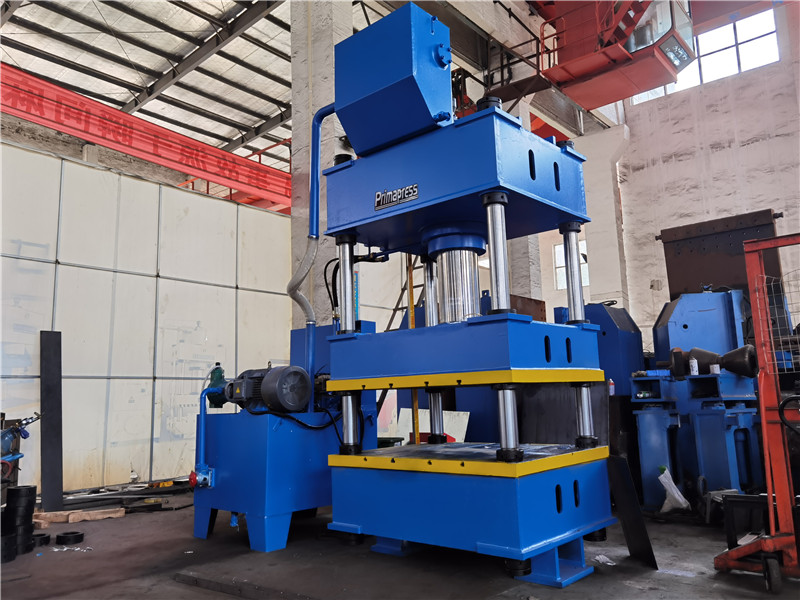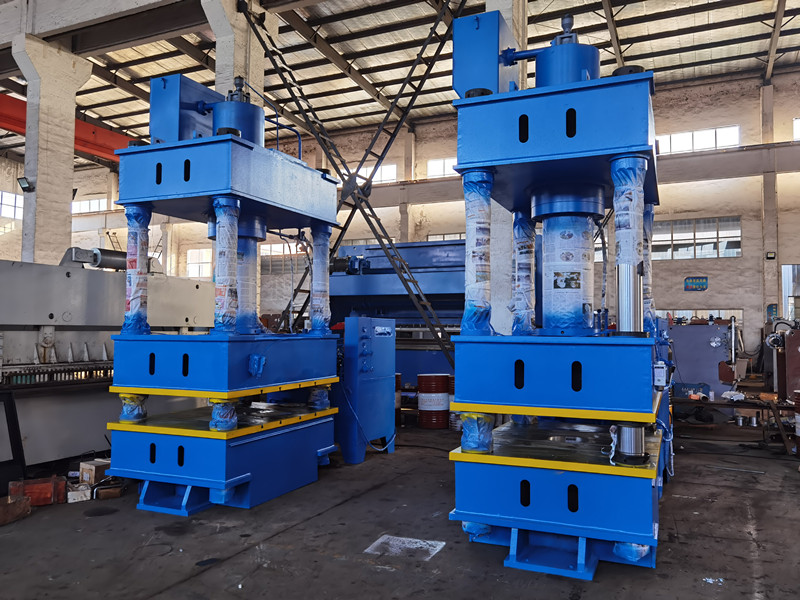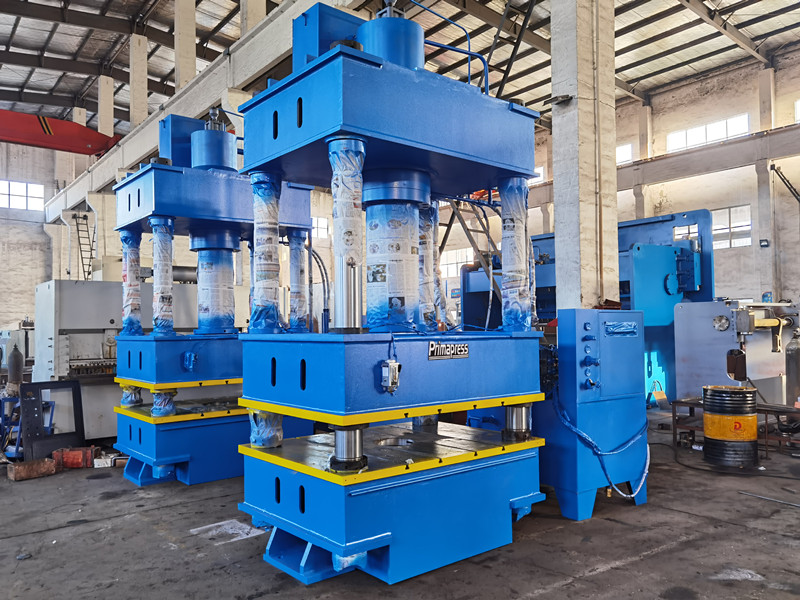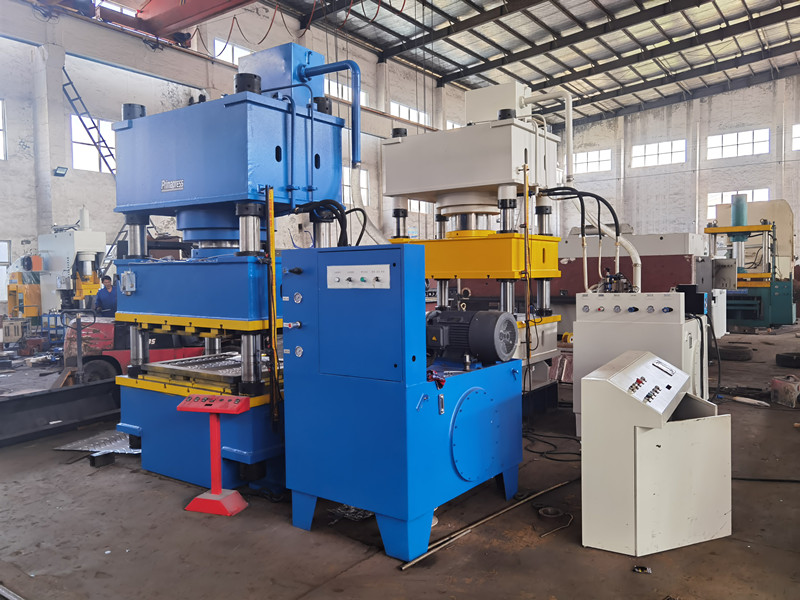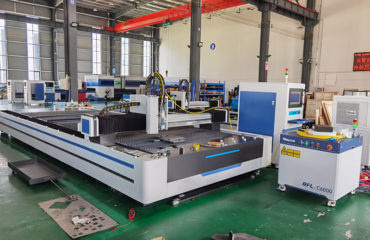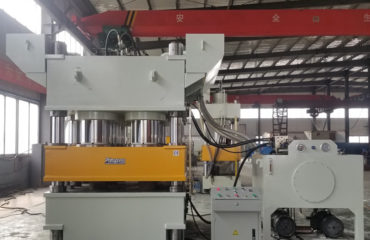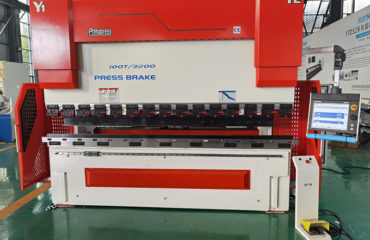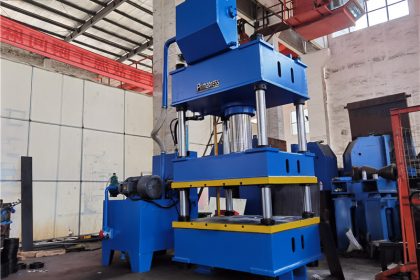
Detailed introduction and operating instructions of the four-column deep drawing hydraulic press machine
Four-column deep drawing hydraulic press machine is a kind of mechanical equipment that uses the static pressure of hydraulic oil delivered by an oil pump to process metal, plastic, rubber, wood, powder and other products. Its principle is to use Pascal’s law to apply deep drawing hydraulic press machineure transmission machinery, and there are many varieties.
It is often used in pressing processes and press forming processes, such as forging, stamping, cold extrusion, straightening, bending, flanging, sheet deep drawing, powder metallurgy, pressing and so on.
Four-column deep drawing hydraulic press machine is composed of a host, an electric control mechanism and a hydraulic system. The main engine part includes the fuselage, main cylinder, ejector cylinder and liquid filling installation, etc.; the power mechanism is composed of oil tank, high pressure pump, low pressure control system, electric motor and various pressure valves and directional valves; electrical installation is in accordance with the hydraulic system rules. Program, select the regular working method, complete the regular process action cycle under the instruction of the signal; the power mechanism is under the control of the electrical installation, through the pump, the oil cylinder and various hydraulic valves, to complete the energy conversion, conditioning and transportation, Complete the cycle of various technological actions.
The four-column deep drawing hydraulic press machine has an independent power mechanism and electrical system. It adopts button centralized control. It can complete three operation modes: adjustment, manual and semi-automatic: the working pressure of the machine, the pressing speed, the speed of no-load fast down and slow down, all can be based on the process Demand adjustment, and can complete the top-receiving process, no top-receiving process, and stretching process.
Detailed characteristics, different brands of hydraulic timing have partial differences, let’s take Xingdi Y32 as an example to understand the performance and characteristics of the four-column deep drawing hydraulic press machine.
1. The three-beam and four-column structure is adopted. The beam and plate are made of integral solid steel plate, which prevents welding deformation and stress deformation of the welding structure, ensuring its working accuracy, and the overall structure is compact and space-saving;
2. The cylinder body and beam plate of the traditional equipment are processed separately. After bolts and flanges are connected, it is easy to form fatigue and short life. This equipment completes the integration of cylinder beam casting, effectively avoiding the above defects, and has high strength and strong load resistance;
3. The main cylinder adopts a piston-type sub-cylinder structure, and the sub-cylinder is embedded in the main cylinder. The sub-cylinder has a small cross-sectional area and can drive the main cylinder to move down quickly under the condition of low oil volume. When the main cylinder is close to the product, the sub-cylinder stops working, and the master cylinder completes rapid prototyping. When no-load, it has low power consumption and rapid mold clamping, and completes rapid drawing with the lowest power consumption;
4. When smaller parts are formed, the idling stroke of the beam and cylinder can be reduced, the idling time can be reduced, and the length of the guide post and the oil pipeline can be shortened.
In fact, in terms of tonnage, Xingdi can also stop customizing from 20T to 1000T according to actual needs. Different categories can choose appropriate tonnage according to demand. If the request is lower or the parts are smaller, the smaller tonnage can be selected, and the larger tonnage is selected for the higher request and large processed parts.
Operation steps and requests:
1. Operator’s qualifications and requests
1. The operator should be familiar with the equipment’s performance, structure, process principle and control system operation method, and only after passing the training and examination can he start operation.
2. Operators should wear work clothes, safety helmets and protective gloves. Female workers’ braids should be put in caps, and no skirts, slippers or high heels should be worn for work.
2. Inspection preparation before operation
- Before starting and stopping, all the buttons of the electronic control system must be placed in the original position; check whether the operating handles (buttons) and the fastening parts are loose and whether the performance is reliable; the running parts and the table surface are barrier-free Whether the objects, limit installation and safety protection installation are intact.
- Check whether the lubricating points and refueling points are adequately supplied; check whether the electronic control system is good and whether the grounding is proper; all fastening joints must not be loose, and the limit installation and safety protection installation can be perfect; and So that the smooth parts are sufficiently smooth.
3. Select the appropriate equipment process parameters according to the processing drawings (detailed according to the product process card) and set them.
Three, the key steps and precautions in operation
- Perform a test run with an empty stroke for 10 minutes before work, check whether the buttons, switches, valves, limit installations, etc. are sensitive and reliable, and confirm that the hydraulic system pressure is normal, free from jams, overheating and other abnormal phenomena; the working slide moves sensitively After that, you can start work.
2. As long as the no-load test machine is normal, the load test machine can be stopped; the machine must be in good smooth conditions before it can enter normal operation.
- Turn off the main motor, adjust the space position formed by the upper slider and the worktable according to the flange width and thickness of the corrected workpiece, extend the head of the workpiece into the working position and start the left and right lifting motors, according to the correct amount of deformation of the workpiece Adjust the position of the lifting motor, start the main motor, run the upper slider, and stop the flange correction at the correction point of the pressing workpiece; the correction point is affirmed according to the angle ruler and visual inspection experience.
- For different metals and sheets of different thicknesses, the amount of reduction applied should be different. For each different kind of metal sheet, the reduction should be adjusted once and the reduction should be adjusted. It can be read by a steel tape measure.
- For sheets of different thicknesses, you should stop adjusting to a suitable gap and then stop the leveling of the sheets. During the leveling process, it is not allowed to rotate and press the motor to press down the sheets; the distance between the hand and the front end of the slider should not be allowed. Less than 300 mm.
6. When the equipment is working, no one can stand on the side of the workpiece exit; if multiple people operate, one person should follow the command. When the workpiece is turned over or advance and retreat, the operators on both sides must communicate and cooperate closely to ensure that the steps are different.
7. The working system and operating system should be sensitive, precise and reliable, and the slider should not swing.
8. The working mechanism and operating mechanism of the machine should be in harmony with each other, and run responsively, without abnormal noise or jamming.
9. In the course of operation, the oil supply condition of each smooth point should be checked frequently to ensure sufficient oil supply for each smooth point.
10. Clean up all the debris on the workbench, and smooth the welds on the workpiece that may be in contact with the slider and the workbench.
11. During operation, it is absolutely forbidden to start pressing down and lifting installation.
12. If abnormal noise, impact, vibration or obstacles are found, stop the machine for inspection immediately, and resume normal operation after the abnormality is removed.
13. At work, it is necessary to concentrate and pay attention to (check, watch, listen to) the operation of the equipment at any time.
Fourth, the behavior to stop during the operation
1. It is strictly prohibited to use overload and performance.
2. It is strictly forbidden to start the lifting motor when the equipment is working normally.
5. Emergency and response to accidents during operation
1. During operation, if abnormal noise, impact or swing is found, it must be shut down for inspection immediately, and the operation can be continued until the fault is removed.
2. It is strictly forbidden to use the oil cylinder over-travel, and to prevent processing when it is shaking when pressurizing or depressurizing.
3. If the piston of the oil cylinder vibrates or the oil pump makes a sharp sound, the gas should be discharged.
4. It is strictly forbidden to adjust the regulating valve and pressure gauge randomly, and the pressure gauge should be calibrated regularly.
5. Adhere to the oil quality of the hydraulic oil, and the temperature of the working oil must not exceed 45°C. If it is abnormal, the machine will stop.
Six, the operation of resetting to zero is completed
1. When the work is over, cut off the power supply.
2. Clean the equipment and the environment daily.
3, the process products are stacked uniformly.
Seven, equipment maintenance
1. Ensure that the equipment is smooth and good at all times; all vulnerable parts should be replaced in time when they show excessive wear or lose the original performance requirements, and if the parts are damaged, they should be repaired in time.
2, the equipment should be well grounded, and all electrical components should be regularly inspected and repaired, dust removed, and damaged and failed components should be replaced in time.
3. Make a record of shifting shifts, daily equipment inspections, and maintenance records.
